APC's Current-Gen SurgeArrest: A Modern Tear-Down
After our first tear-down, APC wanted to send in a modern equivalent to demonstrate the company's dedication to quality. Follow along as we tear open another power strip and dig deep into its electrical composition.
It Finally Arrived

It took several weeks after we published Let's Take a Trip Inside a Power Strip! to line up a modern equivalent, which we'd use for a follow-up tear-down. But it's here now. Hidden somewhere under this ocean of bubble-wrap is the star of today's show. While I dig it out, you may want to revisit my exploration of APC's old SurgeArrest power strip, the company's thoughtful response to my coverage, and a deconstruction of its BX1000 uninterruptible power supply in Tear-Down: Let's Take a Trip Inside A UPS; I'll be referring back to both features throughout today's piece.
Speaking Marketese
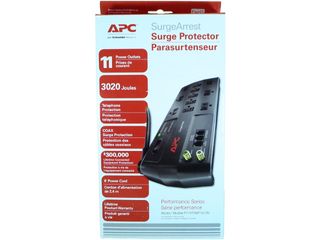
The packaging's front side provides a succinct summary of the bar's key features and a photograph showing all of the major visual and functional aspects. About 3kJ of surge suppression and a $300,000 protection guarantee sound fairly good. But exactly what goes on behind the scenes to give APC so much confidence? We shall find out when we get inside.
Wall Of Text
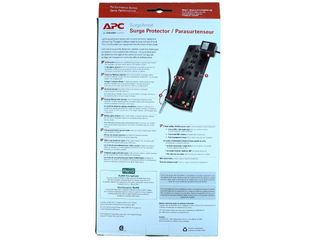
The marketing department went wild on the back side, giving potential buyers a walk-through of each feature listed on the front. On the bottom-left, we see a RoHS compliance declaration followed by the surge protection evaluation method and a list of package contents. At the bottom-right, we have the original owner's equipment protection policy summary, followed by the French translation of surge testing and box contents.
APC omitted headings on the English side. When I do translations, I obsess over making layouts match exactly whenever possible, relatively minor discrepancies like that jump out at me more than they should.
Table Of Contents

Included with the modern SurgeArrest are a user manual, equipment protection policy, a pair of APC-branded cable ties instead of its predecessor's plastic clip, a gold-plated RG6 cable instead of the former's plain RG59, a telephone cable and, of course, the power bar itself.
Old Versus New
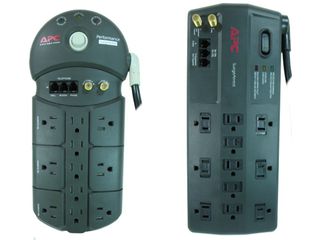
As I mentioned in my original SurgeArrest tear-down, I happen to own three of the old-school models. One was opened for repair after a trace blew up. I used the second one for my tear-down story two months ago. And I'm opening the third for a side-by-side comparison of new versus old.
Let's start with the front's unchanged features (at least as far as the exterior is concerned):
Stay on the Cutting Edge
Join the experts who read Tom's Hardware for the inside track on enthusiast PC tech news — and have for over 25 years. We'll send breaking news and in-depth reviews of CPUs, GPUs, AI, maker hardware and more straight to your inbox.
- you get the same eleven outlets with exactly the same layout
- the same three indicator LEDs for overload, wiring fault and protection working
- phone and coax protections, albeit with a different layout
- rotating cable entry point with 180° of freedom
At first glance, I find the old model more aesthetically pleasing. But the rounded design did cause some inconveniences over the years, such as power bricks not sitting down correctly due to uneven support. From a pure functionality viewpoint, the more industrial modern design is less likely to cause issues with that.
Now let's move on to what is different.
My Little Switches

Have you ever accidentally hit the switch on a power bar? It is The. Worst. Possible. Thing. And it has happened to me two or three times while using the old model with its large rocker switch recessed in that large cup. On the new model, the switch sits down in a slot that's barely finger-wide, making accidental toggling far less likely. Also, APC's newer model uses a combination breaker switch. The old model had its plain switch on top and a separate button-style breaker on the opposite side from the cable entry point.
Following Indications

The three LEDs arranged as an arc over the power switch on the old model look cute. But the nicely aligned lights on the new model look more organized and are much easier to interpret. Granted, you only need to read them once to know what each color means, so readability is not a major concern. However, improved organization does come out better overall in my opinion.
The red LED lets you know there is an issue with the outlet's electrical wiring, the yellow one tells you too much stuff is plugged in and the green one is your indication that the surge suppression is operational. If the green LED stops lighting up while the bar is on, it is your cue to cash in the lifetime replacement warranty.
The Outlets
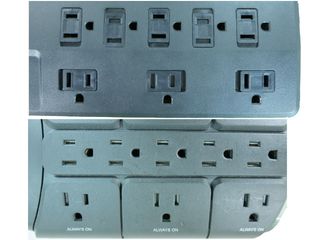
Which childproofing method do you prefer? The new model's manual sliding shutters that you have to close any time you unplug a device, or the old one's interlocked spring-loaded shutters, which force you to simultaneously insert something into both blade slots to clear them? Personally, the amount of force it takes to push plugs through the spring-loaded mechanism bothered me quite a few times. But in terms of safety, it's the better protection of the two, since there's no real way to accidentally bypass it.
Another difference some of you may care about if you use your power bar's switch to turn accessories on or off is that all outlets on the new model are switched. The old model had three always-on transformer pad outlets for devices like broadband modems, routers, switches, telephony adapters, cordless phones and chargers. This is a trade-off related to the new model using a combination breaker switch instead of having separate devices for each function like the old bar.
The Black Labels
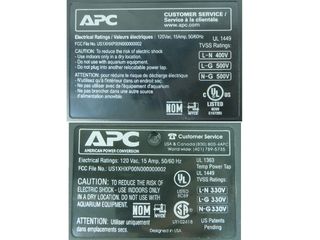
The new model's label has the same warnings in both French and English. Those of you who read my original picture story may remember how I poked a bit of fun at APC for providing different warnings. The “Patent Pending” mention is gone on the new label, and so is the CSA mark.
Surprisingly, the new unit has higher surge suppression voltage ratings than the old unit: 400V line-neutral and 500V for all other pairs versus the older unit's 330V everywhere. Given $300,000 equipment protection, I would have expected clamping thresholds to get tighter (closer to 120VAC or 170VPK) instead of wider to further reduce the amount of let-through. The only way to better understand APC's decisions is to get inside and look more closely at the hardware.
Barging In
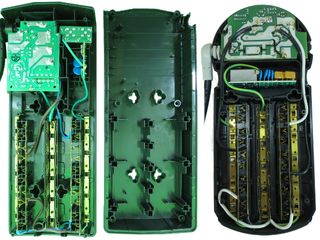
Six screws and a few nudges later, we're in.
The outlet area employs the same layout and strip styles, but is wired slightly differently since the old model had non-switched outlets. APC's new sample has the same daisy-chained grounds for phone and coax protection as my tear-down unit from two months ago, while my third older specimen utilizes a single circuit board handling both functions. I was not expecting that, but hoping for a surprise was the main reason I decided to use my last unopened unit for this story instead of reusing photos from the last one. Moreover, based on serial numbers, this one appears to be older.
Bare Metal

In the previous two tear-downs, the outlet contact strips were either held down by melted plastic, plastic partitions they snapped into or were tangled in wires, making extraction inconvenient to the point that I didn't bother. In the new model, everything can be pulled out with relatively little effort. I decided to take a closer look this time around.
From left to right, the first two strips are different angles of the live and neutral connections behind the power brick pad outlets. The picture conveys the amount of “spring arm” between their wedge-shaped contact tips and the bus strip. The middle strip is the ground. The rightmost two are different angles of the strips used for the live and neutral connections behind the center row outlets; the middle contact has “wings” and the outer ribs to help guide plug blades in-between. As far as I can tell, all three strips are exactly the same as my decade-old SurgeArrest bars.
-
errdizzy I still don't touch APC products anymore. I used to have all TVs, computers and game systems in my house connected to them. It only took a year for the batteries in all of them to die (at different times). I switched the another manufacturer and haven't had a problem since. Going on 2 years now...Reply -
jll544 "Surprisingly, the new unit has higher surge suppression voltage ratings than the old unit"Reply
Actually, not surprising because it's not valid to compare the ratings between the different generations. The old surge protector was rated under UL 1449 2nd Edition, whereas the new one was rated under UL 1449 3rd Edition. The 3rd Edition test applies a much higher current, so the higher voltage is expected. -
SWB02 APC sent you this unit? If so, then knowing it would be subjected to a public teardown and critique, I expect they will have thoroughly inspected it beforehand to ensure it was a shining example of their absolute best workmanship.Reply
Much more interesting would be a teardown of a unit obtained independently through normal retail channels. -
Peter Martin Tripp Lite power surge suppressors for me. ONLY. I would never use anything else.Reply -
Daniel Sauvageau Reply
I wanted to take a look at that but could not find a free copy of it online; only various companies' notes highlighting differences relevant to their respective business. Without access to the original document, I have no idea how comprehensive and accurate those whitepapers's change lists are.14340106 said:Actually, not surprising because it's not valid to compare the ratings between the different generations. The old surge protector was rated under UL 1449 2nd Edition, whereas the new one was rated under UL 1449 3rd Edition. The 3rd Edition test applies a much higher current, so the higher voltage is expected.
For example, GE's version does describe the new test conditions (6kV at up to 500A for 2nd vs 6kV input at up to 3kA for 3rd) but it is preceded by a mention that only type-1 and type-2 SPDs (meter/panel-mount) will be further discussed, which seemed to imply that the above was specific to those types. -
Daniel Sauvageau Reply
They most likely did at least check it out for any obvious issues but then again, the new design has fewer wires attaching to the PCB and none of them directly to the traces from the copper side, which should considerably reduce the potential for handling mistakes.14340759 said:APC sent you this unit? If so, then knowing it would be subjected to a public teardown and critique, I expect they will have thoroughly inspected it beforehand to ensure it was a shining example of their absolute best workmanship. -
merikafyeah Sacrificial surge suppressors are all well and good when you're on a budget, but they still don't hold a candle to non-sacrificial surge suppressors like those from Brickwall and SurgeX. All things considered, the cheaper Brickwall units are actually not THAT much more expensive than the most expensive sacrificial surge suppressors, and they are well worth every penny, especially considering you never need to replace them.Reply
I recommend this unit in particular for its value/$:
http://www.brickwall.com/collections/surge-protectors-home-theater-hdtv/products/eight-outlet-audio-surge-protector
Made in USA, not China like almost every other surge suppressor you can buy today. You get what you pay for, and I learned the hard way with cheap suppressors. -
JackNaylorPE Reply14339730 said:I still don't touch APC products anymore. I used to have all TVs, computers and game systems in my house connected to them. It only took a year for the batteries in all of them to die (at different times). I switched the another manufacturer and haven't had a problem since. Going on 2 years now...
Agreed .... same here .... and replacing the batteries is not done because it's cheaper to buy a new unit. Since The Schneider take over, it's not the same company and certainly not the same product we used to see.
-
Daniel Sauvageau Reply
Do you happen to have an appnote or something that details how Brickwall/SurgeX's "non-sacrificial" surge protection works? Both companies have the exact same diagram that does not give any useful details about it.14341382 said:Sacrificial surge suppressors are all well and good when you're on a budget, but they still don't hold a candle to non-sacrificial surge suppressors like those from Brickwall and SurgeX.
Everything I can find about anything resembling that from other vendors effectively boils down to slapping an LC filter in front of the MOVs to block or dampen most of the high-frequency, high-energy stuff so the MOVs do not need to deal with (as much of) it.
Most Popular




